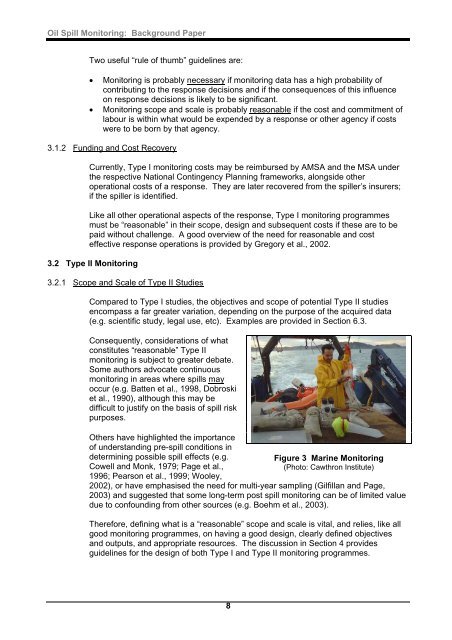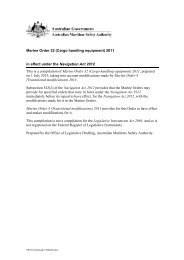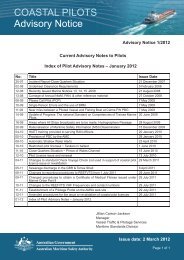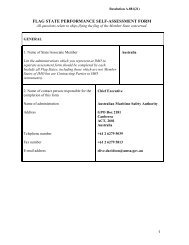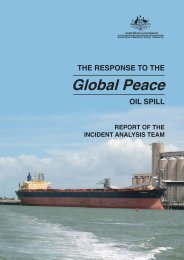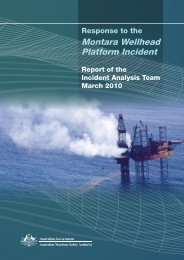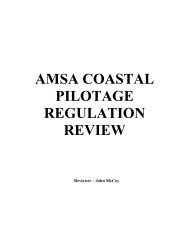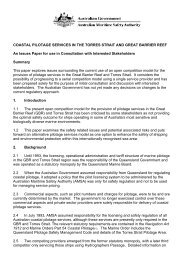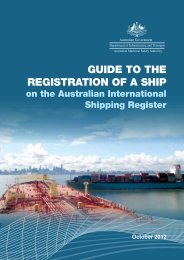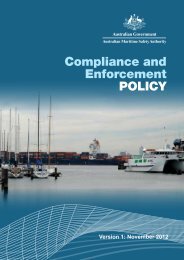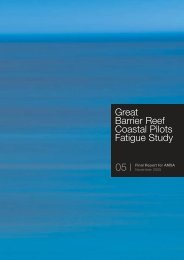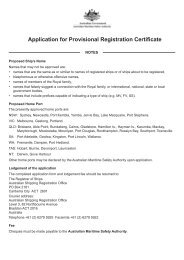Oil Spill Monitoring BACKGROUND PAPER - Australian Maritime ...
Oil Spill Monitoring BACKGROUND PAPER - Australian Maritime ...
Oil Spill Monitoring BACKGROUND PAPER - Australian Maritime ...
You also want an ePaper? Increase the reach of your titles
YUMPU automatically turns print PDFs into web optimized ePapers that Google loves.
<strong>Oil</strong> <strong>Spill</strong> <strong>Monitoring</strong>: Background Paper<br />
Two useful “rule of thumb” guidelines are:<br />
• <strong>Monitoring</strong> is probably necessary if monitoring data has a high probability of<br />
contributing to the response decisions and if the consequences of this influence<br />
on response decisions is likely to be significant.<br />
• <strong>Monitoring</strong> scope and scale is probably reasonable if the cost and commitment of<br />
labour is within what would be expended by a response or other agency if costs<br />
were to be born by that agency.<br />
3.1.2 Funding and Cost Recovery<br />
Currently, Type I monitoring costs may be reimbursed by AMSA and the MSA under<br />
the respective National Contingency Planning frameworks, alongside other<br />
operational costs of a response. They are later recovered from the spiller’s insurers;<br />
if the spiller is identified.<br />
Like all other operational aspects of the response, Type I monitoring programmes<br />
must be “reasonable” in their scope, design and subsequent costs if these are to be<br />
paid without challenge. A good overview of the need for reasonable and cost<br />
effective response operations is provided by Gregory et al., 2002.<br />
3.2 Type II <strong>Monitoring</strong><br />
3.2.1 Scope and Scale of Type II Studies<br />
Compared to Type I studies, the objectives and scope of potential Type II studies<br />
encompass a far greater variation, depending on the purpose of the acquired data<br />
(e.g. scientific study, legal use, etc). Examples are provided in Section 6.3.<br />
Consequently, considerations of what<br />
constitutes “reasonable” Type II<br />
monitoring is subject to greater debate.<br />
Some authors advocate continuous<br />
monitoring in areas where spills may<br />
occur (e.g. Batten et al., 1998, Dobroski<br />
et al., 1990), although this may be<br />
difficult to justify on the basis of spill risk<br />
purposes.<br />
Others have highlighted the importance<br />
of understanding pre-spill conditions in<br />
determining possible spill effects (e.g.<br />
Cowell and Monk, 1979; Page et al.,<br />
1996; Pearson et al., 1999; Wooley,<br />
Figure 3 Marine <strong>Monitoring</strong><br />
(Photo: Cawthron Institute)<br />
2002), or have emphasised the need for multi-year sampling (Gilfillan and Page,<br />
2003) and suggested that some long-term post spill monitoring can be of limited value<br />
due to confounding from other sources (e.g. Boehm et al., 2003).<br />
Therefore, defining what is a “reasonable” scope and scale is vital, and relies, like all<br />
good monitoring programmes, on having a good design, clearly defined objectives<br />
and outputs, and appropriate resources. The discussion in Section 4 provides<br />
guidelines for the design of both Type I and Type II monitoring programmes.<br />
8


